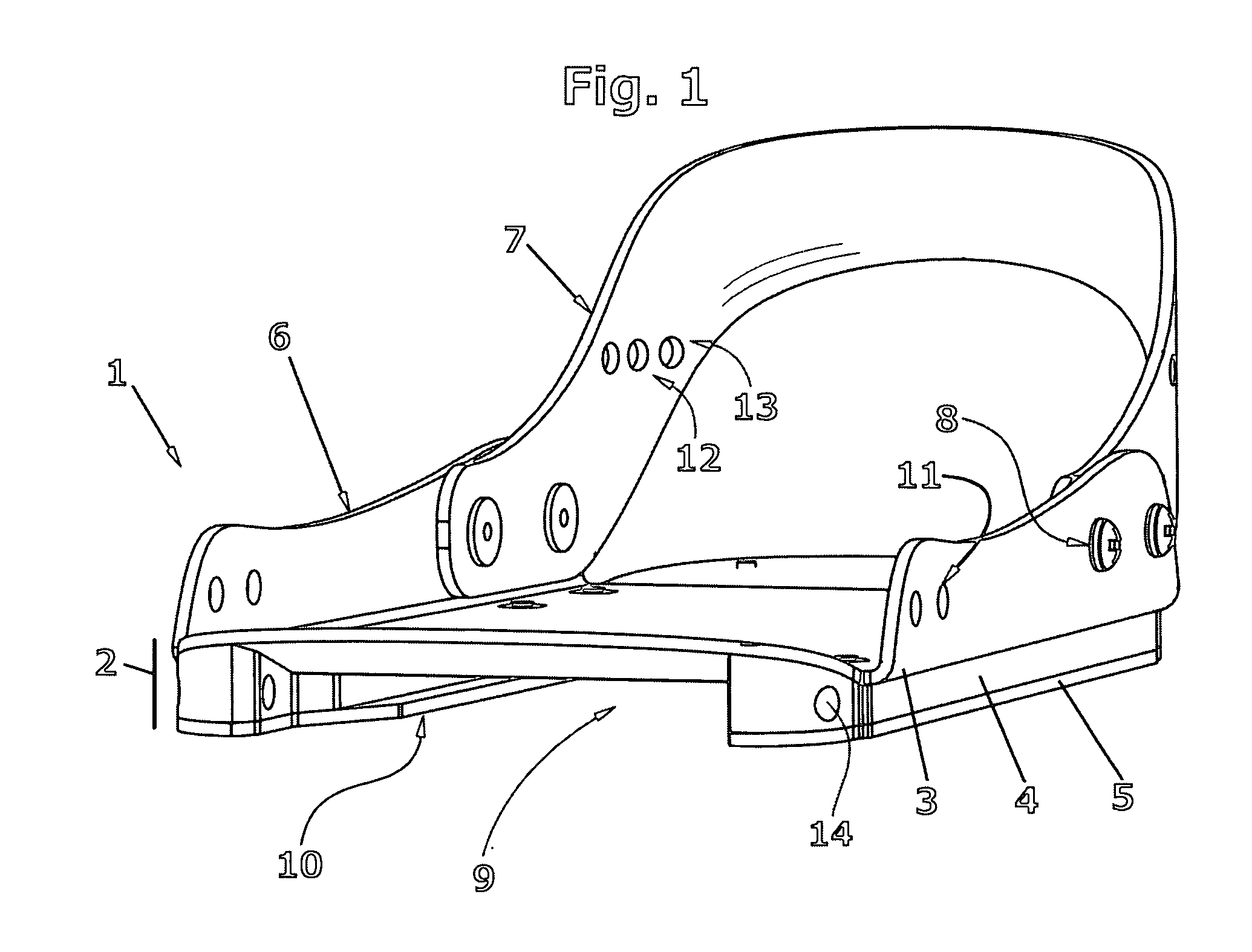Splitboard bindings
a technology of splitboards and bindings, applied in the field of splitboards, can solve the problems of increasing weight, instability, and decreasing the torsional stiffness (or spring constant) of the boot bindings, and achieve the effects of eliminating weight and height, increasing weight, and instability
- Summary
- Abstract
- Description
- Claims
- Application Information
AI Technical Summary
Benefits of technology
Problems solved by technology
Method used
Image
Examples
example 1
[0125]A Drake F-60 snowboard binding with integral heel cup and highback was modified in a shop by removing the base plate and 4-hole disk and substituting in their place a sheet of 2.5 mm aluminum with side rails folded up to form a shallow channel for the boot.
[0126]A three dimensional CAD design was sent to a local sheetmetal house that used a CNC (computer numerically controlled) laser cutter to cut the outline and holes for the aluminum parts necessary for the bindings. Sheetmetal press brakes were then used to bend the channels of the bindings. Similarly, a CNC milling machine cut out the UHMW polyethylene spacers from a sheet of 16 mm thick plastic. This machine provided all holes, the outline, and contoured surfaces.
[0127]Using mounting bolts, the heel and toe straps and highback were secured in place. A total of 10 screws, countersunk, were placed at the circumference of the base along each side of the sandwich to secure the plastic spacer materials (webs) in position betwe...
example 2
[0130]Mechanical comparisions were made using a splitboard and boot binding assembly of the prior art versus that of Example 1. A Voile “Splitdecision 166” splitboard was used for the comparisons, and for the prior art testing, Drake F-60 snowboard bindings were mounted as recommended by the manufacturer on the Voile mounting hardware. The boot bindings were assembled in snowboard riding configuration for these comparisons.
[0131]Physical measurements of the two boot bindings were also made and are recorded in Table 1.
[0132]
TABLE 1Prior ArtExample 1Distance from plane of board to bottom of26mm14mmbootWidth in contact with board under lateral80mm120mmloadWeight per boot binding1182g1015g
[0133]To measure deformation under lateral strain, which is related to spring constant K of the boot bindings, the snowboard was clamped to a vertical surface so that the highback of the boot bindings were mounted parallel to the floor. An 11.3 kg weight was then clipped onto the top of the highback, a...
example 3
[0137]A block of UHMWPE, 25 mm thick by 100 mm by 75 mm, is trimmed to fit between the lateral and medial spacers of an integral boot binding lower of FIG. 10. The rear height of the block is trimmed and rounded to fit easily under the toe riser. A thin rectangular pad is formed from the front of the block to protect the board surface from abrasion by the toe riser and serve as a shim during telemark ski touring. Using the boot bindings toe pivot holes of Example 1 as a drill guide, a transverse hole through the block is made. This hole is dimensioned to accept a captive bushing (see for example FIG. 21) for use with the longer toe pivot pins. Board mounting holes are also drilled and countersunk, so that the new toe mounting assembly can be fitted onto the existing inserts of the board. A second block is shaped for the other board. These components go into a boot binding interface conversion kit, or “split kit”, for use with the integral boot binding lower of the invention.
[0138]
TA...
PUM
 Login to View More
Login to View More Abstract
Description
Claims
Application Information
 Login to View More
Login to View More - R&D
- Intellectual Property
- Life Sciences
- Materials
- Tech Scout
- Unparalleled Data Quality
- Higher Quality Content
- 60% Fewer Hallucinations
Browse by: Latest US Patents, China's latest patents, Technical Efficacy Thesaurus, Application Domain, Technology Topic, Popular Technical Reports.
© 2025 PatSnap. All rights reserved.Legal|Privacy policy|Modern Slavery Act Transparency Statement|Sitemap|About US| Contact US: help@patsnap.com



